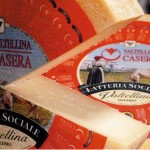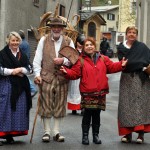Taste the historical gastronomic tradition of the Valtellina
Valtellina: Bitto’s story
Taste this renowned cheese, an incredible local speciality
The Bitto is Valtellina’s most renowned and important cheese, an incredible local speciality that is produced only here, high up on the mountains in the pastures.
Producing this cheese requires skill, expertise, sacrifice and incredible hard work!
Let’s go learning something more about it.
⇒ Watch the full web serie Valtellina Slow Tour
Video full text: Bitto’s story
Adventures in Valtellina!
Go! Go!
I’d like to suggest you come travelling with me,
you could wear tourist backpacks, what do you reckon?
Go back to your mum!
This is a classic pannier basket; I don’t know what it’s called here.
It’s used for carrying lots of things up to the mountain pastures.
What did they use to carry in it?
They used to carry straw, wood, dung, potatoes.
It was really heavy.
But what sort of folk were they?
They were the hardy mountain folk of the Valtellina.
They were folk who have turned this into one of the most popular regions for tourism.
They farm and produce large quantities of typical products.
I’ve come to the Valtellina to find out precisely more about them.
This where they sell the Bitto,
Valtellina’s most renowned and important cheese.
An incredible local speciality that is produced only here,
high up on the mountains in the pastures.
Producing this cheese requires skill, expertise, sacrifice and incredible hard work.
Let’s go in!
How wonderful and what a lovely smell!
This is a traditional shop here in Morbegno,
that has looked like this since 1883.
Tradition demands that the classic Bitto is sold here,
the one that is even served to the Pope!
This shop is somewhere not-to-be missed by the slow tour tourist.
This is the cellar,
like the vaults of a bank, only it’s where they keep Bitto and not gold.
The real treasure is the historic recollection of Mr Ciapponi,
whose family has been producing and selling Bitto della Valtellina for four generations.
It’s called Bitto, like the river that flanks Morbegno,
and that’s the name given to the cheese.
Mr Ciapponi knows all the secrets behind the Bitto,
he tells me how the cows that were to provide the milk were chosen.
One would walk in the stables among the cows that were lying down.
Then a small hammer, a wooden one not iron, would be used to strike their knees, shin and hoofs.
When the cow reacted it was chosen because it was healthy.
So then it would be taken up onto the mountain!
Between June and October the cows would be taken to heights above 1000 metres, and they still are.
Onto the pastures, where the fresh grass and the climate allow the typical Bitto cheese to be produced in situ.
These things are important, true and worth knowing.
Mr Ciapponi tells me that the cheese is still produced now as it was then,
using the same tools.
This is called libra, it’s placed in the middle of the vat and is turned.
It holds kernels of corn, if the kernel crumbles when it is squeezed it’s not done correctly.
It has to be elastic!
Even the shape of the fascera, i.e. the mould that holds the fresh cheese, is important.
It mustn’t have any sharp edges and has to be smooth and round.
Sharp edges would push inwards allowing the serum to escape more.
During its first year the Bitto must only be matured on wooden beams and treated with care.
It is turned like this – it’s quite heavy – by turning the beam.
After a year it is positioned vertically.
How old is the oldest cheese in here?
Three, two, five, ten years!
What good fortune to have met Mr Ciapponi.
It’s important to treasure his knowledge, so as to continue with this tradition,
this has something extra special about it.
It’s a cheese that with time increases in value.
Time that is slipping us by!
And that adds value to things, as is the case with the Bitto.
Let’s take a photo, here are the two brothers, Dario and Primo!














